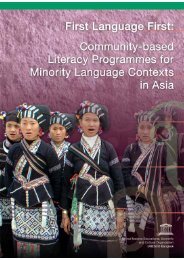Part II.pdf - MTB-MLE Network
Part II.pdf - MTB-MLE Network
Part II.pdf - MTB-MLE Network
Create successful ePaper yourself
Turn your PDF publications into a flip-book with our unique Google optimized e-Paper software.
Health and Personal Hygiene: Malaria is the most common ailment, followed by fever, cough,<br />
colds, flu and diarrhea. All are often fatal among toddlers. There is no health centre in the<br />
community, and no health worker that caters to their needs/problems. They depend on herbal<br />
medicines and healing rituals to help their sick get well. However, there is a health centre in<br />
the nearby town where they can seek health care with free medicines.<br />
Governance: The community is headed by a chieftain they call “Kapitan.” The dynamic of<br />
power is evident with the leadership of the chieftain who depends so much on the members<br />
of the tribe. In every issue and concern that confronts the community, a series of consultations<br />
through general assemblies are called so that the people may decide on a course of action.<br />
The community is peaceful, and has the potential of being a self-sustaining unit; however, it<br />
does need assistance from non-governmental organizations, as well as government agencies,<br />
to improve present living conditions.<br />
Religion: There are three religious sects in the community: Roman Catholic, born-again<br />
Christian and Iglesia ni Kristo. As part of her mission, the pastor’s wife of the born-again<br />
Christians conducts a literacy class and serves as the literacy facilitator.<br />
Industry: The major means of livelihood are farming, (pagtatanim), paid services (hired by<br />
middlemen) for transporting farm products to lowland where transportation is available<br />
(pagpapaupa), gathering honey (pangunguha ng pulot), hunting wild animals (paninilo ng<br />
baboy-damo), and small-scale fishing.<br />
Home and Family Life: Most of the houses are made of bamboo and nipa leaves. Each<br />
household was given specific land area on which their houses were built, but there is no land<br />
title as proof of ownership. The women/mothers stay at home to take care of the children,<br />
wash clothes, cook the food, clean house and upkeep the surroundings while the men go out<br />
to earn the daily subsistence. There were several intermarriages of the tribe with the ‘unat’<br />
(means straight-haired or the lowlanders).<br />
Dialect: They have their own language, which is also called Magbikin. There is no in-depth<br />
study on how the language came about. The dialect has been transmitted from generation to<br />
generation with some modification in spelling/pronunciation because of their association with<br />
the Tagalog and Visayan-speaking people. Unfortunately, the old Aytas did not teach the young<br />
generation their language; hence, there is a diminishing use of the mother tongue among the<br />
members of the tribe, especially among the younger generation. This situation was also brought<br />
about by their intermarriages with the lowlanders and interaction with other residents of the<br />
neighboring towns. The majority of the Magbikin community expressed their desire to preserve<br />
their mother tongue as part of their tribal identity.<br />
A.1.4. Home visitation and interview of key informants – The Action Research Team went around<br />
the community for home visitations, and interviewed some members of the tribe. They were able<br />
to gather information, which validated and supplemented the data/information generated through<br />
focused group discussions.<br />
187
















